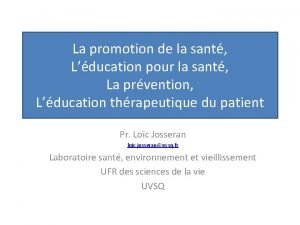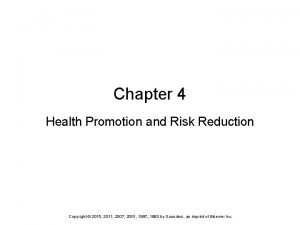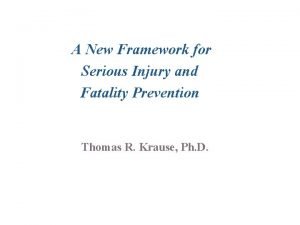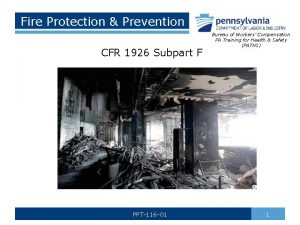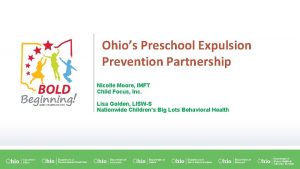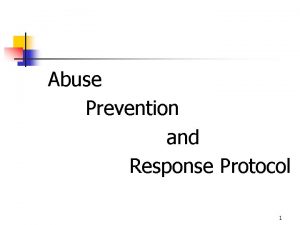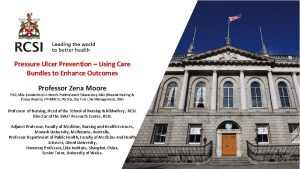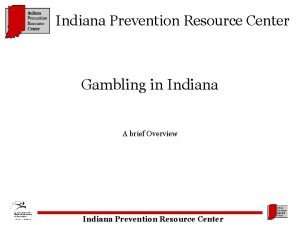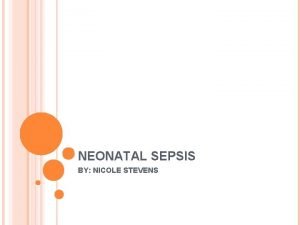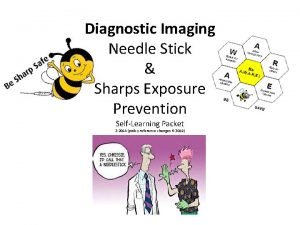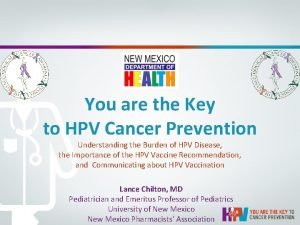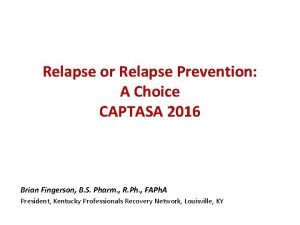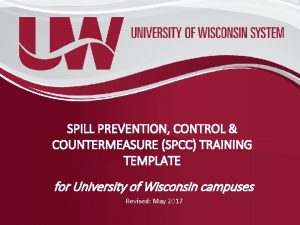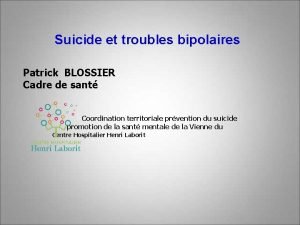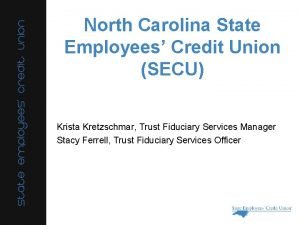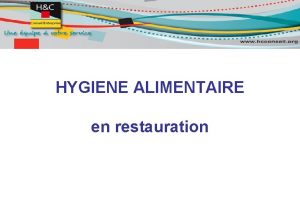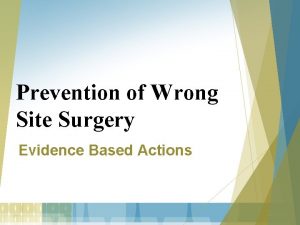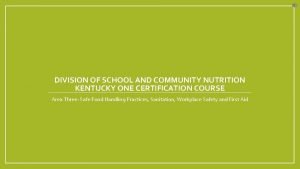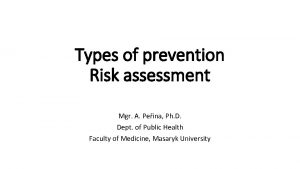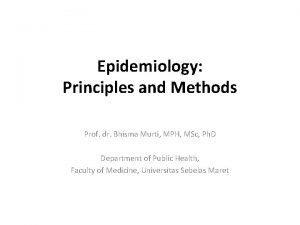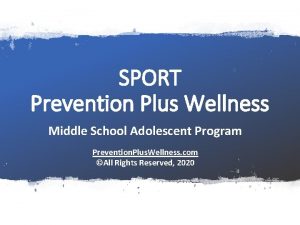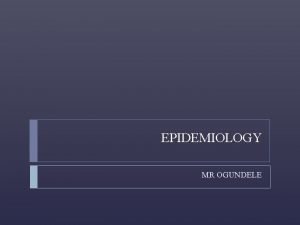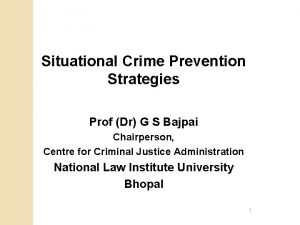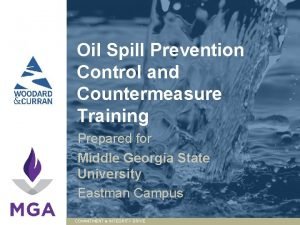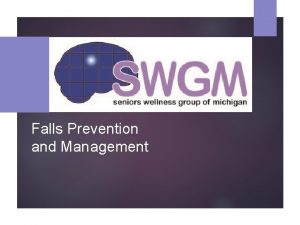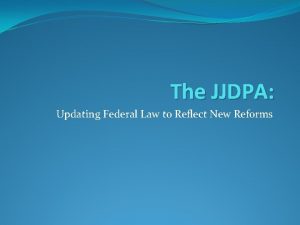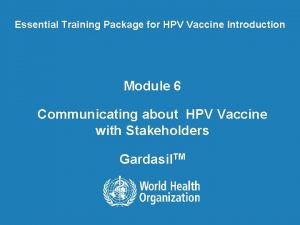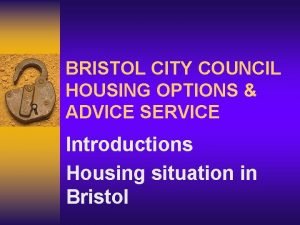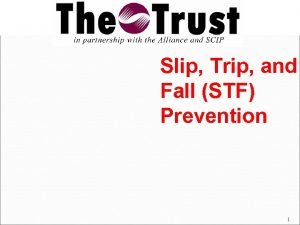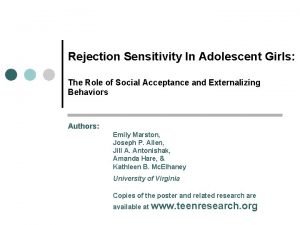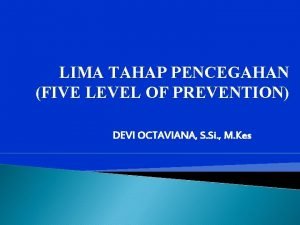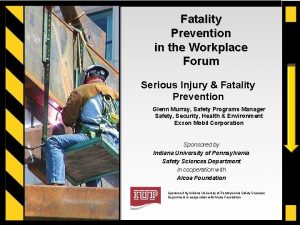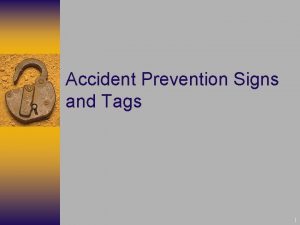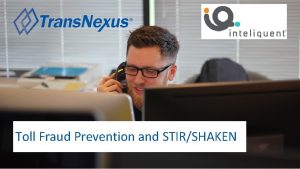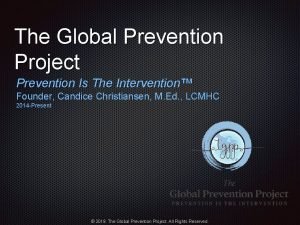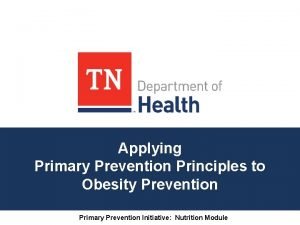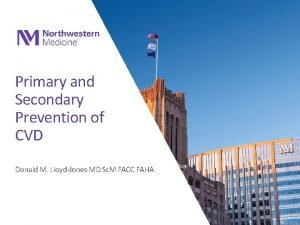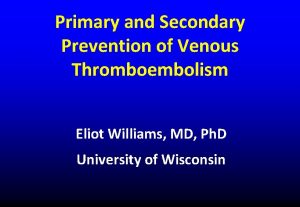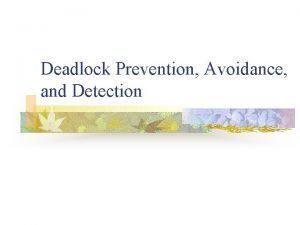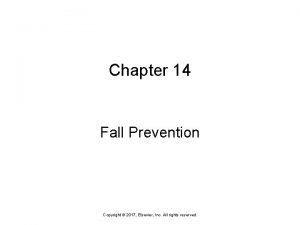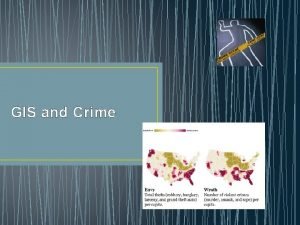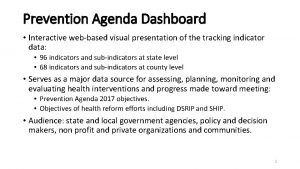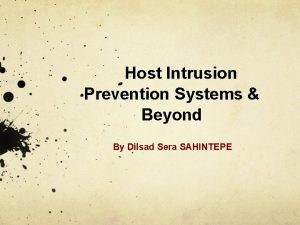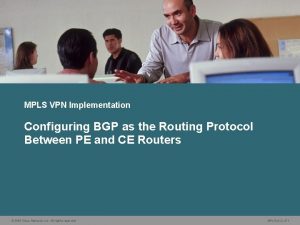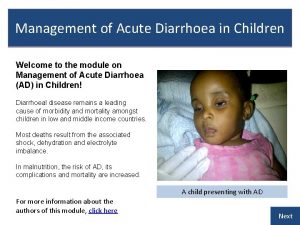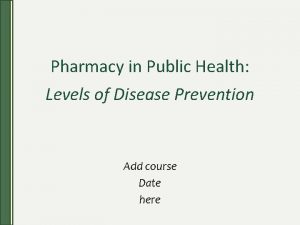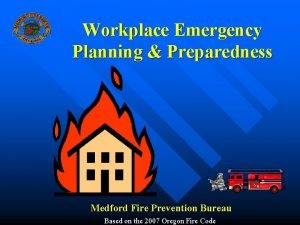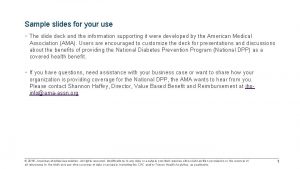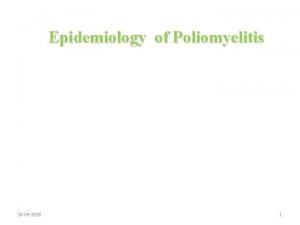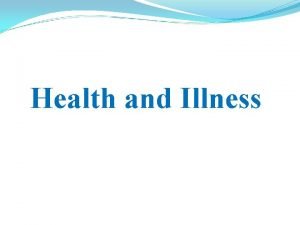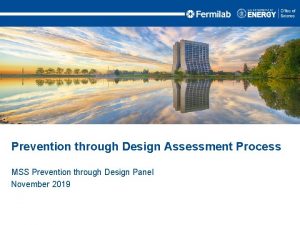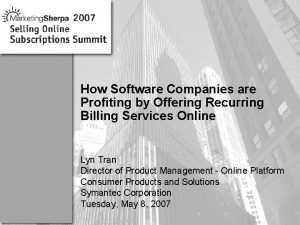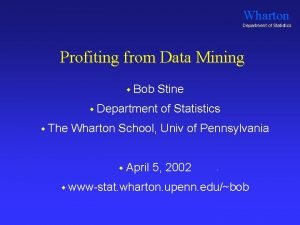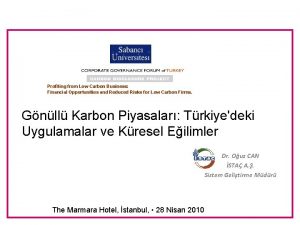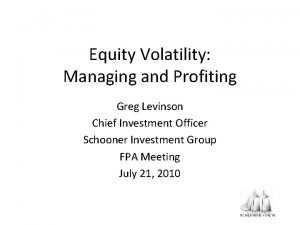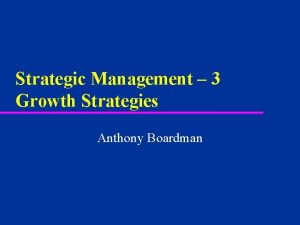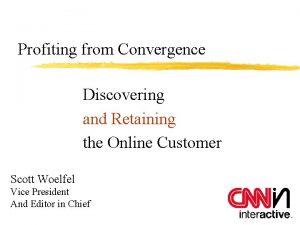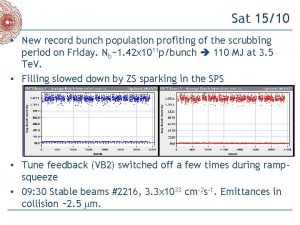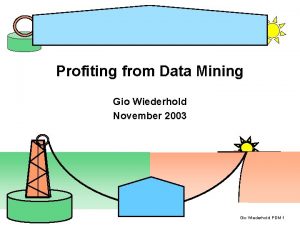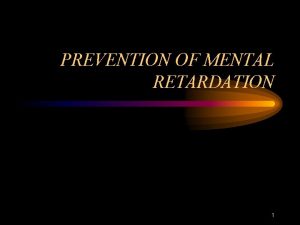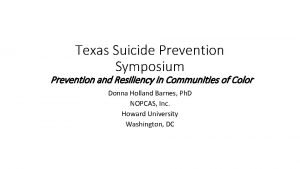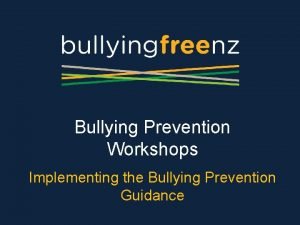Profiting Through Prevention Today n n n A



































































































- Slides: 99

“Profiting Through Prevention”

Today… n n n A broad perspective on the issue of workplace violence (Psychological Harassment) The Canadian experience The anatomy of a violent incident Threat/Risk Assessment Legislative/legal obligations (Bill 168) Prevention programming

What are we talking about… Continuing disagreement regarding the definition and parameters of violence. n Two parameters: n – physical versus Non physical – The source (who is the perpetrator)

Violence Definitions Vary n n n BC – Physical force by a person other than a worker. (HHSR, s. 4. 27) AL – “…threatened, attempted or actual conduct of a person that causes or is likely to cause physical injury (Code, s. 1) Sask. – “…attempted, threatened or actual conduct of a person that causes or is likely to cause injury…” (Regs, S. 37) (includes harassment) Man. - “…attempted or exercise of physical force against a person…” (includes harassment) Ont. (Bill 168) – “…the exercise of physical force by a person against a worker in a workplace…” (includes harassment)

Psychological Harassment “…means an vexatious behaviour in the form of repeated and hostile or unwanted conduct, verbal comments, actions or gestures, that affects an employee’s dignity or psychological or physical integrity and results in a harmful work environment…” Quebec Labour Standards - June 1, 2004

Regulatory Shift As thought there has been a regulatory migration towards the inclusion of “indirect” forms of aggressiveness, frequently referred to as “psychological harassment” Saskatchewan, Manitoba, Quebec and Ontario (pending) include harassment

Growing Pressure to expand the Definition of Violence… We recommend that workplace violence be defined, not only as physical violence but also as psychological violence such as: bullying, mobbing, teasing, ridicule or any other act or words that could psychologically hurt or isolate a person in the workplace. (OC Transpo Inquest – Recommendation #7)

Growing Pressure to expand the Definition of Violence… A Review of the Occupational Health and Safety Act to examine the feasibility of including domestic violence, abuse and harassment as matters subject to Ministry of Labour Investigation and Action Lori Dupont Coroner’s Inquest – December 11, 2007

The Evolution of “Bullying” (General/Personal Harassment) Historically the focus of attention was on “physical workplace violence” n Growing evidence to suggest that interpersonal mistreatment has been a contributor n This mistreatment has been described as “verbal”, “indirect” and “passive” n

A General Definition of “Bullying” Workplace bullying is the persistent mistreatment of one or more employees, sometimes by an employee in a position of influence or authority, who, intentionally or unwittingly, subjects others to behaviour that humiliates, demoralizes or otherwise undermines the victim’s credibility, effectiveness and personal wellbeing.

Warning Signs of Bullying n n n Unjust criticism, fault-finding and belittling Communication that embarrasses or humiliates the person privately or publicly Explosive outbursts Intentionally and repeatedly isolating someone Taking credit, undermining or deliberately impeding a person's work Intrusive contact outside of working hours (phone calls, e-mails)

Additional Warning Signs n n n Setting unrealistic goals or deadlines Denying access to information necessary to complete a task Blocking applications for training, leave or promotion Removing areas of responsibilities Unwarranted (or undeserved) punishment Constantly changing work guidelines

Bullying is NOT… n n Objective comments intended as constructive feedback “Reasonable” action taken in a constructive manner to advance a work process A decision based on “reasonable” grounds not to award, promote, transfer… “ Reasonable” administrative action in the course of employment.

Our Working Definition “Any incident in which a person is abused, threatened or assaulted in circumstances relating to their work. These behaviors would originate from customers, co-workers at any level of the organization. This definition would include all forms of harassment, bullying, intimidation, physical threats/assaults, robbery and other intrusive behaviors” (IOL, 1999)

The Canadian Experience Women have 19% higher rate of physical or psychological assaults than the US n Stats Can. 12, 000 women 51% attacked n CUPE 1994 70% reported verbal aggression, 40% struck, 30% grabbed n Sexual Harassment fastest growing compliant since 1991 (Ont. Human Rights Commission) n

Canada in a Global Context n France, Argentina, Romania, Canada, & England reported highest rates of assaults & sexual harassment on the job. (ILO, 1999)

Statistics Canada Criminal violations 1998

Statistics Canada Criminal Violations 2000

Criminal Violations Actual number of persons 1998 Homicide 255 Robbery 19, 572 Criminal 5, 378 2000 319 21, 279 7, 143 Change +25% +9% +33% 9, 921 +18% (Harassment) Sexual 8, 374 (Assault) Assault 8, 0267 10, 3617 +29%

CIWV Preliminary Findings Violence has increased (66%) n Physical violence reported from outside, whereas Psychological from within n 78% have taken concrete steps to act n 53% suggest not enough being done n 91% believe Canada different than US but moving in that direction n

What are the sources of violence?

From Impoliteness to Physical Attack Violence is rarely a spontaneous act but more often the culmination of escalating patterns of negative interaction between individuals

Violence: An Interaction n An interaction between three factors: – Stimulus that leads subject to think this is the only way out – A viable solution to the problem at hand – An organization that facilitates/permits violence, or at least does not stop it from occurring.



The Concept of “Control” High Locus Control Transitory Anxiety Chronic Lack of Control Perceived Injustice Low Locus of Control

The Importance of Control Work Social Physical Interaction

The Behavioural Sequence G A B F E C D

The Case of “Bullying” that Changed Canada’s Legal Landscape

Pierre Le. Brun n n n 12 year employee of OC Transpo (Nov. ’ 86 -Dec. ’ 98) Driver, then Parts Clerk Pronounced stutter and facial ticks at times of stress Complained of being teased, mimicked and ridiculed by co-workers to OH nurse, HR worker, doctor, and supervisor Treated for depression Expressed concern about being labeled a rat and retaliation

Events of April 6, 1999 OC Transpo St. Laurent Repair Complex n Pierre Le. Brun at 2: 40 p. m. begins shooting with a high powered hunting rifle n Kills 4 workers, wounds 2, kills himself n Police TAC Units and paramedics respond, reach deceased at 4: 30 p. m. n

The Letter “ …I’m going to commit an unforgivable act…I have no choice. I’m tired, exhausted and completely backed against the wall…They will never leave me alone. I can’t go on living like this! They have destroyed my life, I will destroy their life…OC Transpo and the unions can’t hide from what they do to me…They will pay dearly for what they’ve done to me. The people who I hold responsible are: (four names listed) along with many others …all I wanted was for them to leave me alone, not to bug me but it was too much to ask. They have spread lies, especially that I was a rat who denounced my own union members to try and have them stop laughing at me. ”

Co-worker Suicide “I have been unable to sleep well since the shooting at OC. The gunman, Pierre had talked with me to great length about it and where to be for a better shot at some managers – as it turned out he shot himself at this location in the loft. I feel guilty as hell for not telling anyone. ” July/99

Post Event Analysis “Pierre Le. Brun worked in a “poisoned” workplace. He was repeatedly harassed due to his speech impediment, his tic disorder… He complained about the ridiculing to a number of individuals at OC Transpo…The personal factors of speech impediment, tic disorder, poor self esteem, anxiety, depression and paranoia exacerbated by workplace factors of chronic harassment and ridicule proved to be a fatal combination…” Dr. Peter Collins (forensic psychiatrist)

Legislative/Legal Responsibilities Common Law Liability • Liability of the employer for the acts of its employees • Liability of the employer for its own acts Statutory Liability • Occupier’s Liability Act • Occupational Health & Safety Act • Human Rights code Criminal Code

Negligence of Employer Rests on the employers awareness of events in its workplace and has responded reasonably based on that knowledge. In essence a duty of care. • Negligent hiring • Negligent retention • Negligent Supervision

Negligent Hiring More developed in the US but has been made in Canada n An employer may have “hired negligently” where a person with known propensities for violence should have been discovered. n – Reference checks, personal interviews, security checks

Negligent Retention n A claim may arise where an employer continues to employ an employee, despite the fact that the employer knew or ought to have known of the employee’s history or propensity for violence, and that the employee engages in a violent act.

Negligent Supervision Often referred to in the US. n The employer can be held liable for negligently retaining an employee, such as an supervisor, whom they were aware had a propensity for violence. n

Statutory Liability n Occupier’s Liability Act – People who are in control over land must ensure that their premises are safe for persons who may be reasonably expected to enter. – There a number of security steps that can mitigate the risk - lighting, intercom, alarm systems, electronic access, ID tags, single reception, etc.

Human Rights Legislation Every Canadian jurisdiction also has Human Rights legislation that protects each of us against discrimination and harassment. Some companies have specific policies regarding harassment and fair work practices. The Human Rights policy may be integrated into your workplace violence prevention policy or it may stand alone.

OH&S Legislation Every Canadian jurisdiction (provincial/territorial/federal) has its own Occupational Health and Safety legislation. This legislation is intended to protect all employees against hazards on the job, including workplace violence.

Workplace Violence Legislation Federal Government Pending

Key Developments Federal Canada Labour Code Regulations, December, 2007 • • Ontario Bill 29, December, 2007 Bill 168, April, 2009

Canada Labour Code II Regulations “Any action , conduct, threat or gesture of a person towards an employee in their workplace that can reasonably be expected to cause harm, injury or illness to that employee”

COHS Regulations Employer must assess and identify factors that contribute to workplace violence. n Past experience n Similar workplaces n Reports of violent incidents n Measures currently in place

COHS Regulations Develop, establish & post a Policy regarding workplace violence. n Commitment to a safe workplace n Dedicate resources to address violence including bullying and teasing. n Communicate factors that might contribute to workplace violence n Assist victimized employees

COHS Regulations Once a policy in place, the employer must establish systematic controls n 90 days after the risk assessment n Prevention measures may include workplace design and processes n Reporting/Investigation n Training n Reviewed every 3 years

The Criminal Code Some acts of violence fall under the Criminal Code just because they happened in a workplace does not change this fact. The Criminal Code covers acts of violence such as: n n n Criminal harassment Uttering threats Hostage taking Sexual assault Assault Murder

Bill 168 • First reading, April 20, 2009 • To protect workers from both physical violence and harassment • Noteworthy: “Domestic Violence”, “Right to Refuse Work”, “Duty to Warn” “Risk Assessment” “Reporting of Violence to MOL”. “Accountability under the OHSA”

Status of Bill 168 Second reading under way n MOL is very committed to its passage n Unclear when it will pass n Will become law 6 months after Royal Assent n

Who Bill Applies To Workplaces with more than 5 employees unless inspector orders otherwise.

Bill 168 ( Employer Responsibility) n n n Policy (posted at a conspicuous place) Assess and identify risks Prevention measures and procedures Reporting/Communicate procedures and appropriate investigative procedures Copy of risk assessment to the JHSC Training obligation

Definition of Workplace Violence “The exercise of physical force by a person against a worker in a workplace that causes or could cause physical injury to the worker” n “An attempt to exercise physical force against a worker in a workplace that could cause physical injury to the worker” n

Definition of workplace Violence Does not cover threats n Unintentional force could be considered “Workplace violence” n Covers acts of violence by members of the public against employees. n

Definition of Workplace Harassment “Engaging in a course of vexatious comment or conduct against a worker in a workplace that is known or ought reasonably to be known to be unwelcome”

Key Features of Harassment Definition Not tied to prohibited grounds under the Human Rights Code n Could be applied to a wide range of conduct n Subjective in scope n

Policy Requirements In writing n Posted in conspicuous place in the workplace if there are 5 or more employees in the workplace n Review” as often as is necessary, but at least annually” n

Workplace Violence Assessment Considerations to take into account: Similar workplaces n Circumstances specific to your workplace n Other elements prescribed by regulation n

Workplace Violence Assessment Must advise the JHSC of the results in writing n Reassess as often as is necessary to ensure that the related policy and program continue to protect workers n

Required elements of a Workplace Violence Program To control the identified risks n For summoning immediate assistance when workplace violence occurs or is likely to occur n For workers to report incidents n Set how the employer will investigate and deal with incidents and complaints n

Duties to Inform and Instruct Employees As “appropriate” on the contents of the policy and program n To provide information – including personal information – related to a risk of workplace violence if: n – Expected to encounter the person in the course of their work – Risk is likely to expose worker to physical injury

Limit on Disclosure Not to disclose more personal information in the circumstances than is “reasonably necessary” to protect the worker from physical injury

Duties to Inform and Instruct Part of the general duty on employer to inform, instruct and supervise a worker under s. 25(2)(a) of the OHSA n Duty to advise re workplace violence risks also applies to supervisors. n

Domestic Violence Duty triggered if the employer becomes aware (or ought to become aware) that domestic violence will likely expose a worker to physical injury in the workplace n Take every precaution reasonable in the circumstances for the protection of the worker n

Required Elements of a Workplace Harassment Program Measures and procedures for workers to report incidents of workplace harassment n Set out how the employer will investigate and deal with incidents and complaints n

Duty to Inform and Instruct Employer must provide information and instruction that is appropriate for the worker

Work Refusals n Employees will have the right to refuse work if workplace violence is likely to endanger himself or herself n No right to refuse work because of harassment

Work Refusal Process Must report to supervisor or employer n Employer must investigate forthwith in presence of a JHSC member or a worker selected by the union or the workers n Worker to remain in a safe place near work station pending investigation n

Work Refusal Process If the worker continues to refuse MOL is to be called n MOL will investigate and decide if workplace violence is likely to endanger the worker n Worker to remain in a safe place pending the investigation n

Enforcement n MOL is to release guidelines in regard to how provisions of Bill 168 will be enforced and applied n Much will depend on the training given to inspectors (currently underway)

Enforcement Questions Will there be a “blitz”? n How far will inspectors go to review violence assessments? n How much detail will the policies and programs need to contain? n Will noncompliance with the policy and program requirements result in higher fines or civil liability? n

Employer Obligations: Workplace Harassment Prevention The development and implementation of a policy and prevention program with respect to workplace harassment. At a minimum: a. Procedures to report incidents of harassment b. Procedures defining how the employer will investigate and address incidents and complaints of workplace harassment.

Note… It is noteworthy that the Bill contemplates an obligation to investigate “complaints” and “incidents”. This suggests the employer obligation to investigate and address harassment is not limited to responding to complaints. The additional word “incidents” suggests a broader, more proactive obligation.

Employer Responsibility for Domestic Violence If the employer is aware or “ought reasonably to be aware” that a domestic violence matter could expose a worker to physical injury, the employer will be required to take reasonable precautions for the protection of the worker.

Right to Refuse to Work Where Risk of Violence The Bill will extend the right to refuse to work where workplace violence or the risk of violence is likely to endanger a worker

Your Road Map to Prevention Policy Hazard Assessment Training & Education Incident Follow-Up Victim Assistance Continuous Program Review Emergency Response Planning Prevention Measures Reporting & Investigation

Workplace Violence Prevention Policy Every organization should have a workplace violence prevention policy that is jointly developed by management and employees. This document is the foundation of your violence prevention program. Prevention Policy

Violence Prevention Policy should • Communicate your organization’s commitment to preventing workplace violence • Provide an overview of your violence prevention program • Establish clear standards of behaviour • Apply to all employees, managers, contractors and clients (e. g. customers, patients, students)

Hazard/Risk Assessment To effectively prevent workplace violence you need to have a good understanding of workplace violence risk factors. Your workplace specific hazard assessment will build on this understanding and must include input from both management and employees. Hazard Assessment

The Importance of “Risk” Assessment A comprehensive risk/hazard assessment is the foundation on which to develop a workplace specific violence prevention program while ensuring legislative compliance. It is a logical starting point

The Nature of “Risk” Two components when thinking of risk assessment n The risk associated with an individual who may be potentially aggressive n The organizational risks relating to design, work processes, etc.

History of Violence in your Workplace Some form of survey of employees at all levels of the organization n Consult relevant internal documents and reports n Identify risk factors in your workplace n Inspect the workplace n

Workplace Trends in Similar Organizations Obtain information from relevant sources such as: n n n Insurer WSIB Occupational, Health & Safety enforcement agency Local police (security) Union

Risk Assessment Employee Interviews n Employee Interviews: – Interview representative cross-section of employees/management – Interviews should be done on a confidential basis – Consistent questions

Risk Assessment Work Site Audit n n Review of physical facilities Conduct observational tours of the workplace Look for environmental risk factors (exits, barriers, ID, etc. ) Utilize a risk identification checklist

Risk Assessment Work Site Audit Categories to include on a risk assessment checklist: n Access control n Escape opportunities n Visibility n Security and surveillance systems n Parking areas, exterior, building perimeter n Cash handling (if applicable) n Remote work/work alone (if applicable) n Health care and community sector (if applicable) n Service sector (if applicable)

Prevention: The Next Step Your hazard/risk assessment will help identify the most significant concerns in your organization. The next step is to develop specific measures that will eliminate or minimize these hazards

Before Launching Prevention measures, consider: n n n Communicating the results of your assessment and the prevention plan Explain the hazards identified Describe the changes Explain the reason behind the identified change Emphasize the positive and preventive aspects of your program

Developing Preventive Measures Your hazard assessment will identify the most significant concerns for your organization. The next step is to develop specific measures that will eliminate or minimize these hazards. Preventive measures include training and educating employees about workplace violence, as well as making improvements or changes to your workplace. Prevention Measures

Developing Preventive Measures When developing preventive measures, you should consider: Workplace design – includes the physical lay-out of the workplace and the use of signs, locks or physical barriers, lighting and electronic surveillance. Administrative practices - decisions you make about how you do business, such as hours of operation and staffing levels. Work practices - safe-guards you take while you are actually doing the job.

Reporting & Investigating Workplace violence is frequently under reported. Every workplace should have a clearly defined system set up for the reporting, recording and investigating incidents or possible incidents of violence. Reporting & Investigation

Emergency Response Planning From an both an personal and organizational perspective, it is essential that you have specific plans in place ahead of time that clearly outline how to respond to a serious incident. The plan should be thorough enough to deal with most incidents, but easy enough to understand remember. Emergency Response Planning

Victim Assistance In the aftermath of an incident of workplace violence, traumatized people may require emotional and medical support. Victim Assistance

Incident Follow-up Incident follow-up is part of your ongoing efforts to assess hazards and improve prevention and response strategies Incident follow-up occurs some time after the incident has been investigated and after recommendations for prevention have been made. It involves taking a second look at the situation Incident Follow-Up

Training & Education and training are a very important part of Training & any violence prevention Education program. The exact content and type of training necessary will depend on the results of your workplace hazard assessment and your workplace-specific prevention program.

Program Review Program review should occur at least annually … and more often that if any of the following situations apply: üYour organization has experienced an increase in violent incidents üYour organization has undergone a significant change (e. g. relocation, addition of new shifts, a significant change in business circumstances) üThere have been legislative changes that affect your organization Program Review

Where to From Here… n n n Violence in the Workplace: Prevention Guide – Canadian Centre for Occupational Health & Safety – 1 -800 -668 -4284 Violence in the Workplace, Eric Roher, Carswell Publishing – 1 -800 -387 -5164 Human Resources Guide to Workplace Violence, Norman Keith, Canada Law Book Civil Liability for Sexual Abuse & Violence in Canada, Elizabeth Grace, Butterworths Any of these overheads – gfrench@rogers. com

Overheads gfrench@rogers. com
 Primary prevention secondary prevention tertiary prevention
Primary prevention secondary prevention tertiary prevention Proposal kickoff meeting agenda
Proposal kickoff meeting agenda Today lesson or today's lesson
Today lesson or today's lesson Today meeting or today's meeting
Today meeting or today's meeting Today's lesson or today lesson
Today's lesson or today lesson We are going today
We are going today Today's lesson or today lesson
Today's lesson or today lesson Just for today i will try to live through this day only
Just for today i will try to live through this day only Disadvantages of tangential sawing
Disadvantages of tangential sawing Night of the scorpion themes
Night of the scorpion themes Through one man
Through one man Furcation involvement classification
Furcation involvement classification Sorin ursoniu
Sorin ursoniu International standards on drug use prevention
International standards on drug use prevention Professional nursing practice: concepts and perspectives
Professional nursing practice: concepts and perspectives Follow the four r's (read right reduce and ride) when
Follow the four r's (read right reduce and ride) when Prévention primaire
Prévention primaire Health promotion and levels of disease prevention
Health promotion and levels of disease prevention Chapter 5 lesson 3 health
Chapter 5 lesson 3 health Serious injury and fatality prevention
Serious injury and fatality prevention Tsunami
Tsunami Diabetes prevention program outcomes study
Diabetes prevention program outcomes study Prévention primaire
Prévention primaire Prevention and control of poliomyelitis
Prevention and control of poliomyelitis What is the subpart for fire protection and prevention
What is the subpart for fire protection and prevention Expulsion
Expulsion Global hiv prevention coalition
Global hiv prevention coalition Abuse prevention and response protocol
Abuse prevention and response protocol Preventio ja promootio
Preventio ja promootio Sskin bundle
Sskin bundle Indiana prevention resource center
Indiana prevention resource center Prevention of typhoid fever ppt
Prevention of typhoid fever ppt Prevention of puerperal sepsis
Prevention of puerperal sepsis Needle stick injury prevention images
Needle stick injury prevention images Hpv cancer prevention
Hpv cancer prevention Relapse prevention jeopardy
Relapse prevention jeopardy Spill response plan example
Spill response plan example Vivien blossier
Vivien blossier Secu estate planning
Secu estate planning Cap sur la prévention
Cap sur la prévention Prévention des tiac en restauration collective
Prévention des tiac en restauration collective Wrong site surgery prevention
Wrong site surgery prevention Choking prevention
Choking prevention Type of prevention
Type of prevention Aims of epidemiology
Aims of epidemiology Sport prevention plus wellness
Sport prevention plus wellness Primordial prevention
Primordial prevention 25 situational crime prevention techniques
25 situational crime prevention techniques Spill prevention control & countermeasures training
Spill prevention control & countermeasures training Fall prevention quiz for nurses
Fall prevention quiz for nurses San francisco fire prevention
San francisco fire prevention Prévention dso
Prévention dso Robbery prevention
Robbery prevention What is season
What is season Prevention hpv
Prevention hpv Chapter 19 disease transmission and infection prevention
Chapter 19 disease transmission and infection prevention Injury prevention safety and first aid
Injury prevention safety and first aid Homelessness prevention team bristol
Homelessness prevention team bristol Prevention
Prevention Suicide prevention chain teach
Suicide prevention chain teach Sport prevention plus wellness
Sport prevention plus wellness Prevention of anemia in adolescent girl
Prevention of anemia in adolescent girl How to not get mosquito bites
How to not get mosquito bites Asthetis
Asthetis Chapter 16 infection prevention and control
Chapter 16 infection prevention and control Workplace fatality prevention
Workplace fatality prevention Accident prevention signs and symbols
Accident prevention signs and symbols Levels of prevention of diabetes mellitus
Levels of prevention of diabetes mellitus Robocall captcha gateway
Robocall captcha gateway The global prevention project
The global prevention project Spectrum of prevention
Spectrum of prevention Primary prevention examples
Primary prevention examples Conclusion of balance diet
Conclusion of balance diet Secondary prevention
Secondary prevention Intergranular corrosion prevention
Intergranular corrosion prevention Recurvte
Recurvte Deadlock prevention avoidance and detection
Deadlock prevention avoidance and detection Upaya promotif dan preventif menurut leavel dan clark
Upaya promotif dan preventif menurut leavel dan clark Chapter 14 fall prevention
Chapter 14 fall prevention Uses of gis in crime prevention
Uses of gis in crime prevention Birthday attack definition
Birthday attack definition Army suicide prevention training
Army suicide prevention training Prevention agenda dashboard
Prevention agenda dashboard Ips intrusion
Ips intrusion Contoh tertiary prevention
Contoh tertiary prevention As path override
As path override Cyber crime prevention luxembourg
Cyber crime prevention luxembourg Stakeholders in hiv prevention
Stakeholders in hiv prevention Prevention of acid rain
Prevention of acid rain Prevention of diarrhoea
Prevention of diarrhoea Health promotion and levels of disease prevention
Health promotion and levels of disease prevention Deamonte driver
Deamonte driver Medford fire prevention
Medford fire prevention Management of dog bite ppt
Management of dog bite ppt Street homeless prevention team southampton
Street homeless prevention team southampton Diabetes prevention program ppt
Diabetes prevention program ppt Prevention and control of poliomyelitis
Prevention and control of poliomyelitis Protocole légionellose ehpad
Protocole légionellose ehpad Chapter 26 infectious disease prevention and control
Chapter 26 infectious disease prevention and control Illness prevention definition
Illness prevention definition
















